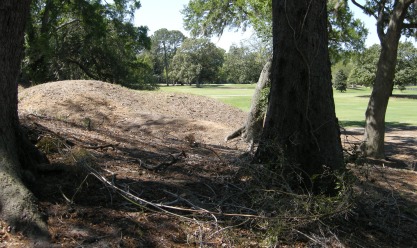Although Union General Sherman outnumbered Confederate General Hardee 7 to 1 (with troops that were better equipped, better led, and convinced of their destiny), it took Sherman 10 days of maneuvering to capture the city.
The reason is the ring of historic forts that encircle Savannah. I saw four of them today on a breathtaking tour with five military historians, researchers, and re-enactors. Although I was the ostensible reason for the gathering, I quickly became small fry tagging along. They avidly swapped details of weapons, uniforms, and events, and laughed at each others’ sophisticated jokes that I simply didn’t get.
We started at Fort Jackson, a Revolutionary War fort guarding the narrowest part of the Savannah River (now guarded by a Hyatt and Westin), some seven miles from the ocean. Anticipating a war with France or Britain, President Thomas Jefferson had ordered the earthen structure to be rebuilt with brick.
I stood on the high rampart feeling the two-century old cold, stiff wind coming off the river. It was hard to imagine the swampy air, thick with huge mosquitos and tiny gnats, that killed way more soldiers than enemy gunpowder. As important as this location was, it was considered an awful assignment.
Next we drove to Fort Boggs—or its remains. One of our party had arranged for the Savannah Country Club (established 1794) to let us onto their grounds. The place is normally closed on Mondays, so our little group (plus three excited Club VIPs) had the place to ourselves.
We found miles of earthworks that had been the star-shaped fort, protecting Savannah’s east. Boggs had a large number of huge cannons, and our historians eagerly compared old maps to determine the exact locations of the various weapons. The sharpest-eyed among us also found several pieces of period pottery as we walked from mound to mound. Better than a hole-in-one any day. Thanking our Club VIPs, we caravanned south to isolated Rose Dhu Island, now used as a 300-acre camp by the national Girl Scouts. Tramping almost an hour through brush, we saw miles of earthworks, rifle pits, connector trenches, and the heights on which cannons had guarded the Little Ogeechee River just a few miles from the Atlantic.
Thanking our Club VIPs, we caravanned south to isolated Rose Dhu Island, now used as a 300-acre camp by the national Girl Scouts. Tramping almost an hour through brush, we saw miles of earthworks, rifle pits, connector trenches, and the heights on which cannons had guarded the Little Ogeechee River just a few miles from the Atlantic.
After a quick late lunch, we sped west to Fort McAllister, at which two of our historians had each worked. On the south bank of the meandering Ogeechee River, observed the very pragmatic architecture of the enormous earthen-walled fort, and walked underground to barracks, powder magazines, and other structures. We saw black cannons along with their wooden carriages, ramrods, and other equipment.
After arriving at the well-guarded city of Savannah, Sherman had decided that this would be the place he’d make contact with the U.S. Navy and its much-needed supplies. After getting his forces into place, Sherman watched from across the river as a depleted Confederate army surrendered. The exposed city would quickly fall in the coming week.
In earlier, far less heady days, these were the same Union troops Sherman had personally led—as a division commander at Shiloh, and as a corps commander at Vicksburg.
His triumph on this very spot, which I had anticipated through eight months of vacation planning and studying, had me feeling melancholy. In only two days I had developed a crush on Savannah, with its sad history just below its elegant surface.


